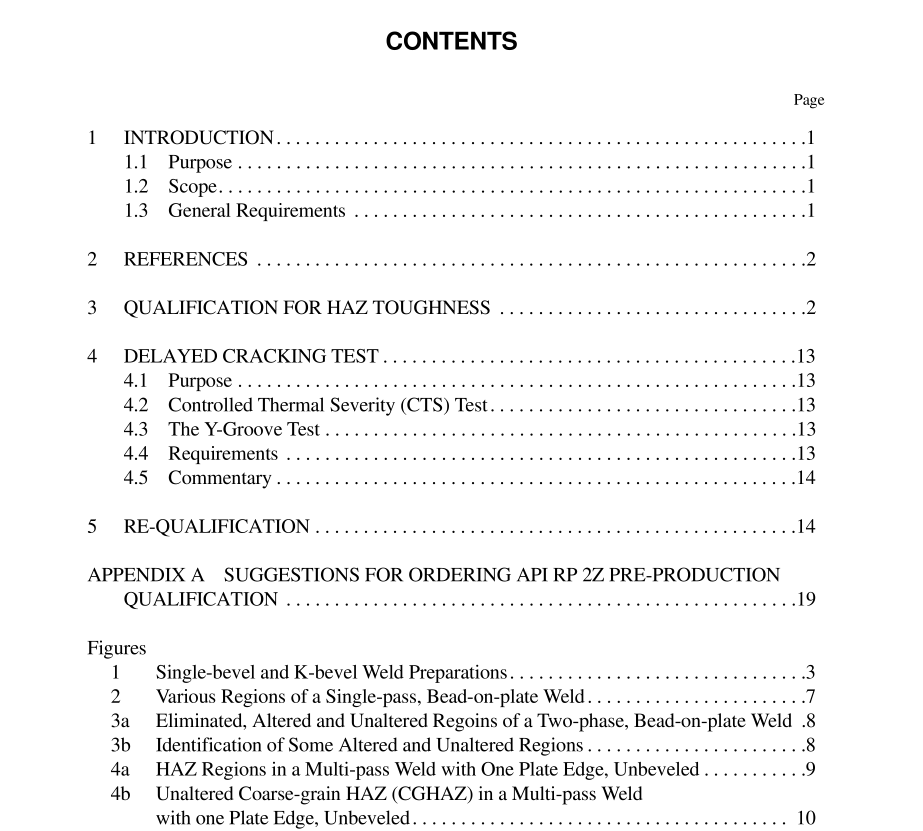API RP 2Z pdf download

API RP 2Z pdf download.Recommended Practice for Preproduction Qualification for Steel Plates for Offshore Structures
1.2 SCOPE
This Recommended Practice covers requirements for Preproduction qualification, by special welding and mechanical testing, of specific steelmaking and processing procedures for the manufacture of steel of a specified chemical composition range by a spe- cific steel producer. This is a Recommended Practice for material selection and qualification, but not for the performance of pro- duction weld joints. This Recommended Practice was developed in conjunction with, and is intended primarily for use with, API Specifications 2W and 2Y. However, it may be sued as a supplement to other material specification s (e.g., API Specification 2H) if so desired.
1.3 GENERAL REQUIREMENTS
1.3.1 Unless otherwise specified, the testing recommended by this practice need only include material from a single heat of steel produced to the specific range of chemical composition to be qualified. 1.3.2 The plate processing, welding, and testing shall be conducted by or under the control of the steel producer, but shall be witnessed by a third party or a representative of a purchaser. 1.3.3 The test results, together with a detailed description of the processing of the steel, shall be documented by the producer and a copy provided to the purchaser. It is not intended, however, that proprietary information be included in the documentation. It is intended that the steel producer’s “know-how” shall remain confidential. It is necessary, however, that sufficient information be included in the documentation package so that a purchaser can confirm at a later date that all essential procedures are being fol- lowed. At the very least, the manufacturer’s process shall be designated by a code number or designation sufficient to provide traceability of process variables. 1.3.4 The chemical composition of the steel, as determined by heat analysis, shall conform to the requirements of the applicable industry standard under which it is to be produced. 1.3.5 Documentation shall include a complete characterization of the base metal properties of the steel tested, including the following: a. Complete chemical composition, listing the elements in section 5.2 and all additions. b. Tensile test results, including stress-strain curves to peak load. c. Charpy V-notch transition curves for absorbed energy, lateral expansion opposite the notch, and fracture appearance. Each transition curve shall consist of a minimum of 12 specimens (at least 4 temperatures, sufficient to define the upper and lower shelf and 50% FATT). Samples for new qualifications to be mid-thickness with T-L orientation, at the following for locations: 1. mother plate head, mid width 2. mother plate head, plate edge 3. mother plate tail, mid width 4. mother plate tail, plate edge. d. Drop-weight nil-ductility temperature. e. Hardness traverse. f. For new qualifications, results of centerline segregation control tests, to include macroetch of both slab and plate for concast, plate only for ingot cast steel. 1.3.6 Any reference to a steel having API RP 2Z qualification shall be accompanied by reference to the tested heat input range, CTOD test temperature, material strength or grade, and thickness.
3 Qualification for HAZ Toughness
3.1 Each pre-qualification shall consist of preparation of three butt welds using test plates with either a K-bevel or single-bevel joint preparation (See Figure 1), subjection to agreement between purchaser and manufacturer. The weld shall be parallel to the final rolling direction and at mid width of mother plate. Test plates shall be of the maximum thickness intended for inclusion within the scope of the pre-qualification. 3.1.1 Pre-qualification test welds shall be made in the flat position using mechanized SAW process except that other mecha- nized welding process may be employed for the root pass and for the lowest heat input. The maximum angular distortion after welding and release of restraint shall not be greater than two degrees. 3.1.2 The welding consumables for pre-qualification welding shall be selected so that the CTOD fracture toughness of the weld metal in the final heat-treatment condition exceeds the required CTOD of the HAZ materials by at least 0.13 mm (0.005 in.) at –10°C (14°F), or at the temperature selected.









